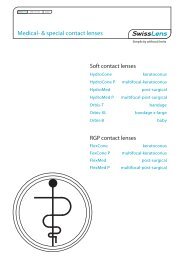Soft contact lens (Toris K/HydroCone)
Soft contact lens (Toris K/HydroCone)
Soft contact lens (Toris K/HydroCone)
Create successful ePaper yourself
Turn your PDF publications into a flip-book with our unique Google optimized e-Paper software.
SOFT CONTACT LENS(TORİS K) FITTING IN PATIENTS WITH<br />
KERATOKONUS<br />
L. Yavuz, Ö. Rodop Özgür, A.Y. Aydın Oral, V. Togrul, S. Öskan<br />
Istanbul ,Turkey<br />
Introduction:<br />
Keratoconus, a degenerative disorder characterized by thinning of<br />
the cornea, can result in substantial distortion of vision.<br />
Traditionally defined keratoconus occurs in approximately 4 to 600<br />
persons per 100,000 (0.004% to0.6%) in the general population, but a<br />
considerably higher percentage (5.7% to 10%) of patients with<br />
previously undiagnosed clinical keratoconus or keratoconus-like<br />
topographic patterns seek relief from their irregular astigmatism at<br />
<strong>contact</strong> <strong>lens</strong> and refractive surgery clinics. Many treatment choices<br />
include spectacle correction and <strong>contact</strong> <strong>lens</strong> wear, collagen cross<br />
linking, intracorneal ring segments implantation and finally<br />
keratoplasty. Contact <strong>lens</strong>es are commonly used to reduce<br />
astigmatism and increase vision.<br />
In this study ,we evaluate the visual outcomes of <strong>Toris</strong>-K <strong>contact</strong><br />
<strong>lens</strong>es for patients who can not be corrected with spectacles.<br />
Matherial-method:<br />
Ninty-six eyes of 72 keratoconus patients who had keratometric<br />
values from 44.5 to 72.44 were included to the study. Forty percent<br />
of patients had mild (55)keratoconus was graded according to the<br />
table 1. <strong>Toris</strong> K silicone hydrogel soft <strong>contact</strong> trial <strong>lens</strong>es were<br />
fitted to these eyes with keratoconus (table 2). The initial trial <strong>lens</strong><br />
was selected according to the protocol shown on table 3. Final <strong>lens</strong><br />
selection was based on clinical performance . Lens stabilisation<br />
and movement was assessed after 30 minutes <strong>lens</strong> fitting.
Afterwards the proper <strong>lens</strong> diopter was found with over refraction<br />
and best corrected visual acuity (BCVA) was detemined.<br />
Table1: Grading of keratoconus<br />
Table 2: Type of <strong>Toris</strong>-K <strong>lens</strong>es.
Table 3: Fitting protocole for <strong>Toris</strong>-K <strong>contact</strong> <strong>lens</strong>es<br />
1. a) Determine the grade of keratoconus (topography) 1-2 or 3-4<br />
b) Vcc > 0.6 and/or keratometry > 6.80 mm: (<strong>Toris</strong> K12)<br />
Vcc < 0.6 and/or keratometry < 6.80 mm: (<strong>Toris</strong> K34)<br />
2. Determine the base curve & diameter:<br />
grade 1-2: r0 = 8,00 / ØT = 14,00 mm<br />
grade 3-4: r0 = 7,80 / ØT = 13,70 mm<br />
Results:<br />
Best-corrected spectacle visual acuity of 20/40 or better was noted<br />
in 30.2% of eyes and increased to 85% after the toris-k <strong>contact</strong> <strong>lens</strong><br />
fitting. BCVA increased to 20/20 in 90% of mild keratoconus<br />
patients. Moderate keratoconus patients gained at least three lines<br />
increase and 10% of patients did not have any progress (table 3).<br />
None of the patients stated a problem during <strong>lens</strong> fitting. No<br />
complication was observed.<br />
Table 3: Distribution of BCVA with spectales and toris k <strong>lens</strong> fitting.<br />
Visual acuity<br />
(feet:decimal)<br />
BCVA of eyes with<br />
spectacle(%)<br />
20/20:(1.0) 0 (%0) 26 (%27)<br />
20/25(0.8) 1 (%1.01) 22 (%23)<br />
BCVA of eyes with<br />
<strong>Toris</strong>-k(%)<br />
20/30(0.7) 3 (%0.31) 20 (%20.8)<br />
20/40(0.5) 25 (%26) 14 (%14.5)<br />
20/50(0.4) 24 (%25) 12 (%12.5)<br />
20/60(0.3) 12 (%12.5) 2 (%2.02)<br />
20/80-20/100(0.2) 17 (%17.7) 0 (%0)<br />
20/120-20/200(0.1) 14 (%14.5) 0 (%0)
Conclusions:<br />
In the initial stages of keratocone, it is likely that the visual acuity<br />
can be improved with spectacles or spherical or thoric hydrophilic<br />
<strong>contact</strong> <strong>lens</strong>es. But when the disease progresses, the cornea<br />
becomes more irregular and common optical corrections fail to<br />
improve visual acuity. At this time, it is necessary to consider the<br />
adaptation of other types of <strong>contact</strong> <strong>lens</strong>es. Using the described<br />
fitting technique, excellent visual results were obtained with the<br />
soft <strong>lens</strong> alone in those eyes with astigmatic errors no greater than<br />
4D . Jain and Sukhija reported BCVA better than 20/40 as 100% for<br />
moderate and 96% for sever keratoconus with Rose K <strong>contact</strong><br />
<strong>lens</strong>es. Sengor et al reported improvement in visual acuity with<br />
piggyback systems compared with rigid <strong>lens</strong>es alone. They noted<br />
improvemet in visual acuity in 89.7% and no alteration in 10.3% of<br />
the eyes. Similarly, visual acuity 20/40 or better was found in %85 of<br />
eyes with <strong>Toris</strong> K soft <strong>lens</strong>es in our study.<br />
In conclusion, <strong>Toris</strong> K silicone hydrogel soft <strong>contact</strong> <strong>lens</strong>es increase<br />
the BCVA successfully. They can be considered in mild and<br />
moderate keratoconus when spectacles do not increase BCVA<br />
adequatly.











